What would your future-you have to say to you?
The no-pants guide to spending, saving, and thriving in the real world.
What would your future-you have to say to you?
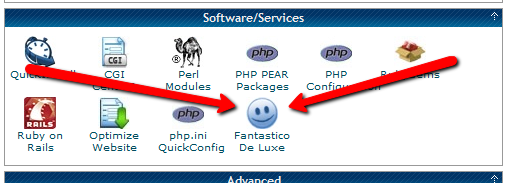
In this installment of the Make Extra Money series, I’m going to show you how to set up a WordPress site. I’m going to show you exactly what settings, plugins, and themes I use. I’m not going to get into writing posts today. That will be next time.
I use WordPress because it makes it easy to develop good-looking sites quickly. You don’t have to know html or any programming. I will be walking through the exact process using Hostgator, but most hosting plans use CPanel, so the instructions will be close. If not, just follow WordPress’s 5 minute installation guide.
Assuming you can follow along with me, log in to your hosting account and find the section of your control panel labeled “Software/Service”. Click “Fantastico De Luxe”.

On the Fantastico screen, click WordPress, then “New Installation”.
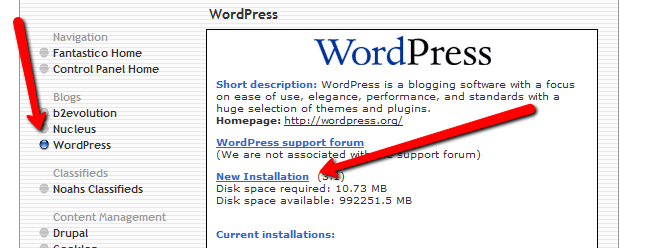
On the next screen, select your domain name, then enter all of the details: admin username, password, site name, and site description. If you’ll remember, I bought the domain http://www.masterweddingplanning.net. I chose the site name of “Master Wedding Planning” and a description of “Everything You Need to Know to Plan Your Wedding”.
Click “install”, then “finish installation”. The final screen will contain a link to the admin page, in this case, masterweddingplanning.net/wp-admin. Go there and log in.
After you log in, if there is a message at the top of the screen telling you to update, do so. Keeping your site updated is the best way to avoid getting hacked. Click “Please update now” then “Update automatically”. Don’t worry about backing up, yet. We haven’t done anything worth saving.
Next, click “Settings” on the left. Under General Settings, put the www in the WordPress and site URLs. Click save, then log back in.
Click Posts, then Categories. Under “Add New Category”, create one called “Misc” and click save.
Click Appearance. This brings you to the themes page. Click “Install Themes” and search for one you like. I normally use Headway, but before I bought that, I used SimpleX almost exclusively. Your goal is to have a simple theme that’s easy to maintain and easy to read. Bells and whistles are a distraction.
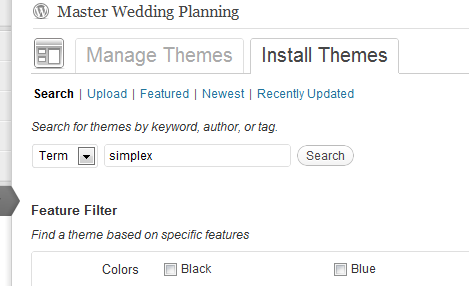
Click “Install”, “Install now”, and “Activate”. You now have a very basic WordPress site.
A plugin is an independent piece of software to make independent bits of WordPress magic happen. To install the perfect set of plugins, click Plugins on the left. Delete “Hello Dolly”, then click “Add new”.
In the search box, enter “plugin central” and click “Search plugins”. Plugin Central should be the first plugin in the list, so click “install”, then “ok”, then “activate plugin”. Congratulations, you’ve just installed your first plugin.
Now, on the left, you’ll see “Plugin Central” under Plugins. Click it. In the Easy Plugin Installation box, copy and paste the following:
All in One SEO Pack Contact Form 7 WordPress Database Backup SEO SearchTerms Tagging 2 WP Super Cache Conditional CAPTCHA for WordPress date exclusion seo WP Policies Pretty Link Lite google xml sitemaps Jetpack by WordPress.com
Click “install”.
On the left, click “Installed Plugins”. On the next screen, click the box next to “Plugins”, then select “Activate” from the dropdown and click apply.
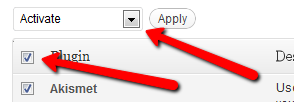
Still under Plugins, click “Akismet Configuration”. Enter your API key and hit “update options”. You probably don’t have one, so click “get your key”.
The only tool I worry about is the backup. It’s super-easy to set up. Click “Tools”, then “Backup”. 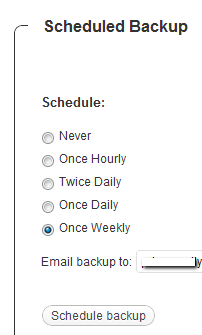
Scroll down to “Schedule Backups”, select weekly, make sure it’s set to a good email address and click “Schedule Backup”. I only save weekly because we won’t be adding daily content. Weekly is safe enough, without filling up your email inbox.
There are a lot of settings we’re going to set. This is going to make the site more usable and help the search engines find your site. We’re going to go right down the list. If you see a section that I don’t mention, it’s because the defaults are good enough.
Set the Default Post Category to “Misc”.
Visit this page and copy the entire list into “Update Service” box. This will make the site ping a few dozen services every time you publish a post. It’s a fast way to get each post indexed by Google.
Click “Save Changes”.
Uncheck everything under “Email me whenever…” and hit save. This lets people submit comments, without actually posting the comments or emailing me when they do so. Every once in a while, I go manually approve the comments, but I don’t make it a priority.
Select “Custom structure” and enter this: /%postname%/
Click save.
Set the status to “Enabled”, then fill out the site title and description. Keep the description to about 160 characters. This is what builds the blurb that shows up by the link when you site shows up in Google’s results.
Check the boxes for “Use categories for META keywords” and “Use noindex for tag archives”.
Click “Update Options”.
Check the boxes to remove each of the dates and set the alt text to “purpose” or something. This will suppress the date so your posts won’t look obsolete.
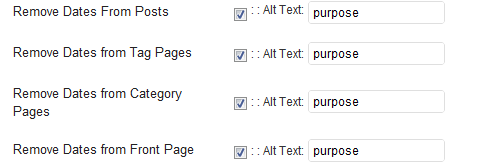
This plugin reinforces the searches that bring people to your site. It’s kind of neat. Skip the registration, accept the defaults and hit save.
Scroll to the bottom and click import. We’ll come back to this.
Select “Caching On” and hit save.
Across the top of the screen should be a giant banner telling you to connect to WordPress.com and set up Jetpack. You’ll need an account on WordPress.com, so go there and set one up. After authorizing the site, you’ll be brought back to the Jetpack configuration screen. Click “Configure” under “WordPress.com Stats”. Take the defaults and hit save.
On the contact configuration page, copy the code in the top section. You’ll need this in a moment.
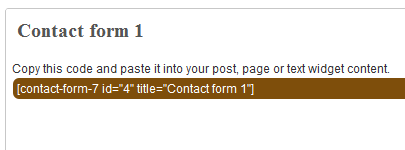
Now, we going to create a couple of static pages. On the left, click “Pages”, then “Add new”.
Name the first page “Contact” and put the contact form code in the body of the page. Hit publish.
Under Appearance, click “Menu”. Enter a menu name and hit save.
Then, under “Pages”, click the box next to “Contact”, “Disclaimer”, and any other policies you’d like to display. Hit save.
Also under Appearance, click “Widgets”. This is where you’ll select what will display in the sidebar. All you have to do is drag the boxes you want from the middle of the page to the widget bar on the right. I recommend Text, Search, Recent Posts, Popular Search Terms and Tag Cloud. In the text box, just put some placeholder text in it, like “Product will go here”. We’ll address this next time.
We’re not going to worry about getting posts in place, yet. That will be the next installment. However, the steps in the next installment could take 2 weeks to implement, and we want Google to start paying attention now. To make that happen, we need to get a little bit of content in place. This won’t be permanent content. It’s only there so Google has something to see when it comes crawling.
To get this temporary, yet legal content, I use eZineArticles. Just go search for something in your niche that doesn’t look too spammy.
Then, click “Posts”, then delete the “Hello World” post. Click “Add new”. Copy the eZine article, being sure to include the author box at the bottom, and hit publish.
To see your changes, you may have to go to Settings, then WP Cache and delete the cache so your site will refresh.
Congratulations! You now have a niche blog with content. It’s not ready to make you any money, yet, but it is ready for Google to start paying attention. In the next installment, I’ll show you how I get real unique content and set it up so Google keeps coming back to show me the love.
This weekend, my wife is off scrapbooking with my mother and sister-in-law. Instead of hanging around the house trying to keep three kids entertained, I’m at my brother’s house, since his wife abandoned him with their kids, too. I’ll let his kids keep mine entertained, and vice versa. Woo!
I am on the Slow Carb Diet. At the end of the month, I’ll see what the results were and decide if it’s worth continuing. For those who don’t know, the Slow Carb Diet involves cutting out potatoes, rice, flour, sugar, and dairy in all their forms. My meals consist of 40% proteins, 30% vegetables, and 30% legumes(beans or lentils). There is no calorie counting, just some specific rules, accompanied by a timed supplement regimen and some timed exercises to manipulate my metabolism. The supplements are NOT effedrin-based diet pills, or, in fact, uppers of any kind. There is also a weekly cheat day, to cut the impulse to cheat and to avoid letting my body go into famine mode.
I’m measuring two metrics, my weight and the total inches of my waist , hips, biceps, and thighs. Between the two, I should have an accurate assessment of my progress.
Weight: I have lost 30 pounds since January 2nd! That’s only 1 pounds since last week. 12 more to meet my goal for February. The difference this week? I’ve cut back on the supplements, to see if they actually make a difference. It would appear they do.
Total Inches: I have lost 16 inches in the same time frame, down 1.5 since last week.
I totally got live this joke.
Are you a compulsive shopper? Money Crashers has some tips to cut that down.
Before I got a smartphone, I relied on a PocketMod for almost everything a smartphone does. Does that make me a geek?
$39Glasses is having a killer sale. $15 off a $40 item is huge.
Tim Ferriss has a guide to slow-carb seasonings. It’s worth reading if your food is boring you.
This is where I review the posts I wrote a year ago. Did you miss them then?
This was Scam Week last year. I had a post on debt scams and scams that target disaster victims. As we roll into flooding season, it’s important to know how these scams work.
I also discussed my attempt to teach my son to savor delayed gratification. It has been working. He makes long-term(for an 11 year old) plans regularly.
Money Problems: Setting Goals was included in the Festival of Frugality.
Your Budget is Worthless was included in the Carnival of Personal Finance.
Brown Bagging Your Way to Savings was included in the Carnival of Money Stories.
Debt Burnout was included in the Totally Money Carnival.
Thank you! If I missed anyone, please let me know.
There are so many ways you can read and interact with this site.
You can subscribe by RSS and get the posts in your favorite news reader. I prefer Google Reader.
You can subscribe by email and get, not only the posts delivered to your inbox, but occasional giveaways and tidbits not available elsewhere.
You can ‘Like’ LRN on Facebook. Facebook gets more use than Google. It can’t hurt to see what you want where you want.
You can follow LRN on Twitter. This comes with some nearly-instant interaction.
You can send me an email, telling me what you liked, what you didn’t like, or what you’d like to see more(or less) of. I promise to reply to any email that isn’t purely spam.
Have a great week!
Today, I continuing the series, Money Problems: 30 Days to Perfect Finances. The series will consist of 30 things you can do in one setting to perfect your finances. It’s not a system to magically make your debt disappear. Instead, it is a path to understanding where you are, where you want to be, and–most importantly–how to bridge the gap.
I’m not running the series in 30 consecutive days. That’s not my schedule. Also, I think that talking about the same thing for 30 days straight will bore both of us. Instead, it will run roughly once a week. To make sure you don’t miss a post, please take a moment to subscribe, either by email or rss.
On this, day 2 of the series, you need to gather all of your bills: your electric bill, your mortgage, the rent for your storage unit, everything. Don’t miss any.
Go ahead, grab them now. I’ll wait.
Did you remember that thing that comes in the plain brown wrapper every month? You know, that thing you always hope your neighbors won’t notice?
Now, you’re going to sort all of the bills into 5 piles.
Pile #1: These are your monthly bills. This will probably be your biggest pile, since most bills are organized to get paid monthly. this will include your credit cards, mortgage(do you rent or buy?), most utilities and your cellphone.
Pile #2: Weekly expenses. When I look at my actual weekly bills, it’s a small stack. Just daycare. However, there are a lot of other expenses to consider. This stack should include your grocery bill, gas for your car, and anything else you spend money on each week.
Pile #3: Quarterly and semiannual bills. I’ve combined these because there generally aren’t enough bills to warrant two piles. My only semi-annual bill is my property tax payment. Quarterly bills could include water & sewer, maybe a life insurance policy and some memberships.
Pile #4: Annual bills. This probably won’t be a large pile. It will usually include just some memberships and subscriptions.
Pile #5: Irregular bills. The are some things that just don’t come due regularly. In our house, school lunches and car repairs fall into this category. We don’t have car problems often, but we set money aside each month so our budget doesn’t get flushed down the drain if something does come up.
Now that you have all of your expenses together, you know what your are on the hook for. Next time, we’ll address income.
I had total diet fail last month.
From April to May, across 4 consecutive weekends, I put a bit over 1500 miles on my car on 4 separate trips. That is something like 10 times my average mileage.
That’s a lot of driving, squeezed around a regular schedule of work. Have you ever tried a drive through for low-carb food? Because of that, and the circumstances of some of my trips, I abandoned my diet on those weekends. Funeral food is rarely low-carb.
By the time those trips were over, I had spent so much time off my diet that “What’s one more sandwich?” became an easy justification. There is a reason I don’t break the rules I give myself. I can’t seem to cheat just once. Once I cross that line, it’s over.
So, instead of cheating on my diet and feeling guilty, I officially dropped it for most of the month of May. I decided it would be easier to get it out of my system than to continue worrying about it.
May’s over, and I’m back on the Slow Carb diet. My little fail cost me 7 pounds and 6.5 total inches(waist , hips, biceps, and thighs). I’m reasonably sure that most of that is water and will evaporate before next weekend.
Best Posts
My goal is to live my life so that I have no regrets at the end of it. That means pursuing my dreams and doing the things I love.
It’s easier to do the things I love when my life isn’t weighed down by the crap I don’t need.
Sweating the Big Stuff wrote a killer post on saving money simply by asking. Often, the easy things work.
Shopping Online: The Money-Saving Secret was included in the Festival of Frugality.
Money Problems: Paying Off Debt was included in the Carnival of Personal Finance.
5 Ways to Help Your Friends Stay Out of Debt was included in the Totally Money Blog Carnival.
Should Pupils Focus on Personal Finance was included in the Yakezie Carnival.
Thank you! If I missed anyone, please let me know.
There are so many ways you can read and interact with this site.
You can subscribe by RSS and get the posts in your favorite news reader. I prefer Google Reader.
You can subscribe by email and get, not only the posts delivered to your inbox, but occasional giveaways and tidbits not available elsewhere.
You can ‘Like’ LRN on Facebook. Facebook gets more use than Google. It can’t hurt to see what you want where you want.
You can follow LRN on Twitter. This comes with some nearly-instant interaction.
You can send me an email, telling me what you liked, what you didn’t like, or what you’d like to see more(or less) of. I promise to reply to any email that isn’t purely spam.
Have a great week!
Today, I am continuing the series, Money Problems: 30 Days to Perfect Finances. The series will consist of 30 things you can do in one setting to perfect your finances. It’s not a system to magically make your debt disappear. Instead, it is a path to understanding where you are, where you want to be, and–most importantly–how to bridge the gap.
I’m not running the series in 30 consecutive days. That’s not my schedule. Also, I think that talking about the same thing for 30 days straight will bore both of us. Instead, it will run roughly once a week. To make sure you don’t miss a post, please take a moment to subscribe, either by email or rss.
On this, Day 11, we’re going to talk about one method of paying for college.
I have a secret to share. Are you listening? Lean in close: College is expensive.
You’re shocked, I can tell.
The fact is, college prices are rising entirely out of proportion to operation costs, salaries, or inflation. The only thing college prices seem to be pegged to is demand. Demand has gotten thoroughly out of whack. The government forces down the interest rates on student loans, then adds some ridiculous forgiveness as long as you make payments for some arbitrary number of years, creating an artificial demand that wouldn’t be there if the iron fist of government weren’t forcing it into place.
Somebody in Washington has decided that the American dream consists of home ownership and a college education. Everything is a failure. He’s an idiot.
College isn’t for everybody.
Read that again. Not everyone should go to college. Not everyone can thrive in college.
Fewer than half of students who start college graduate. The greater-than-half who drop out still have to repay their loans. Do you think college was a good choice for them?
Then you get the people who major in art history and minor in philosophy. Do you know what that degree qualifies you for? Burger flipping.
Yes, I know. Just having a degree qualifies you for a number of jobs. It’s not because the degree matters, it’s because HR departments set a series of fairly arbitrary requirements just to filter a 6 foot stack of resumes. The only thing they care about is that having a degree proves that you were able to stick college out for 4 years. That HR requirement matters less as time goes on and you develop relevant work experience.
A liberal arts education also—properly done—trains your mind in the skill of learning. First, not everyone is capable of learning new things. Second, not everyone is willing to learn new things. Third, a passion for learning can be fed without college. If you don’t have that passion, college won’t create it. Most of the most learned people throughout history managed without college, or even formal education. Even if you want to feed that passion in a formal classroom, you’re assuming the professors are interested in training your mind instead of indoctrinating it with their views.
Now there are some pursuits that outright require a college education. The sciences like engineering, physics, astronomy, and psychiatry all require college. You know what doesn’t require college? Managing a cube farm. Data entry. Sales. I’m not saying those are bad professions, but they can certainly be done without dropping $50,000 on college.
Some careers require an education, but don’t require a 4 year degree, like nursing(in most states), computer programming(it’s not required, but it makes it a lot easier to break into) and others. Do you need to hit a 4 year school and get a Bachelor’s degree, or can you hold yourself to a 2 year program at a technical college and save yourself 40,000 or more?
That should be an easy choice. Don’t go to college just because you think you should or because somebody said you should, or to get really drunk. College isn’t for everybody and it’s possible it’s not for you.